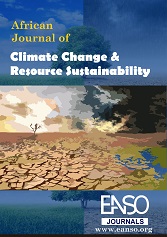Evaluation of the Role of Green Infrastructure in Mitigating Stormwater Runoff: A Case Study of Kinamba Catchment, Kigali City
Ikisiri
Floods are the most common natural disaster worldwide, and failing to evacuate flooded areas or entering flood waters can lead to injury or death. Kinamba catchment faces severe flood events that have led to loss of lives, crop destruction, and infrastructure damage. This study evaluated the impact of Green Infrastructure (GI) on stormwater runoff in the Kinamba Catchment, Kigali City, addressing the escalating challenges of urban flooding and water pollution exacerbated by rapid urbanization and climate change. The research aimed to assess the presence and coverage of GI, determine key factors contributing to stormwater runoff and analyze the effectiveness of GI in managing stormwater, ultimately reducing sewer overflows. Employing a mixed-methods approach, including cross-sectional, descriptive, and scenario-based modelling, the study integrated quantitative data from rainfall-runoff monitoring, GIS mapping, and hydrological modelling using the Rational methods, with qualitative insights from field observations and documentary reviews. The findings revealed a consistently low mean infiltration rate (0.38831) and high discharge variability, indicating a catchment prone to high runoff volumes and extreme events. The key findings from the Kinamba catchment showed the relationship between infiltration and discharge highlighted the complexity of hydrological interactions, while rainfall data from Gitega station underscored the importance of accurate spatial data for modelling. Land use analyses demonstrated a significant loss of green spaces, exacerbating runoff and compromising urban well-being. The study concluded that GI plays a critical role in mitigating stormwater runoff, enhancing infiltration, and reducing peak discharges, but its effectiveness is contingent upon soil properties, rainfall intensity, and maintenance. Therefore, the study recommends a comprehensive GI strategy tailored to high-risk zones, robust data collection and hydrological modelling using Gitega rainfall data, the integration of GI principles into urban planning and policy frameworks, community engagement, and sustainable funding mechanisms to enhance the resilience and sustainability of the Kinamba Catchment.
Upakuaji
Marejeleo
Ahiablame, L., Engel, B., & Chaubey, I. (2012). Effectiveness of low impact development practices: Literature review and suggestions for future research. Water, Air, & Soil Pollution, 223(7), 4253–4273.
Alemayehu, Benitez, A. (2020). Making room for stormwater. [online] Nasikiliza. Available at: Making room for storm water: How floods in Kigali shed light on the need for integrated urban planning and upgrading.
Arthur, N., & Hack, J. (2022). A multiple scale, function, and type approach to determine and improve Green Infrastructure of urban watersheds. Urban Forestry & Urban Greening, 68, 127459. https://doi.org/10.1016/J.UFUG.2022.127459.
Bell, C. D., McMillan, S. K., Clinton, S. M., & Jefferson, A. J. (2016). Hydrologic response to stormwater control measures in urban watersheds. Journal of Hydrology, 541, 1488– 1500. https://doi.org/10.1016/J.JHYDROL.2016.08.049.
Benitez, D. (2020). Making room for stormwater: How floods in Kigali shed light on the need for integrated urban planning and nature-based solutions. The World Bank. Retrieved from https://blogs.worldbank.org/en/nasikiliza/making-room-storm-water-how-floods-kigali-shed-light-need-integrated-urban-planning-and
Chen, J., Theller, L., Gitau, M. W., Engel, B. A., & Harbor, J. M. (2017). Urbanization impacts on surface runoff of the contiguous United States. Journal of Environmental Management, 187, 470– 481. https://doi.org/10.1016/J.JENVMAN.2016.11.017.
Czemiel Berndtsson, J. (2010). Green roof performance towards management of runoff water quantity and quality: A review. Ecological Engineering, 36(4), 351–360. https://doi.org/10.1016/J.ECOLENG.2009.12.014.
Douglas, I., & Lawson, S. (2008). The role of urbanization in flooding in the Global South: A case study of Kigali, Rwanda. Journal of Urban Climate, 10(3), 126–137.
Hou, S., Zheng, N., Tang, L., Ji, X., Li, Y., & Hua, X. (2019). Pollution characteristics, sources, and health risk assessment of human exposure to Cu, Zn, Cd and Pb pollution in urban street dust across China between 2009 and 2018. Environment International, 128, 430–437. https://doi.org/10.1016/J.ENVINT.2019.04.046
Gasasira Higiro, J. (2020). Urban expansion and its impact on flood risks: Case study in Kigali City. Rwanda Journal of Environmental Studies, 12(4), 56–71.
Li, C., Peng, C., Chiang, P. C., Cai, Y., Wang, X., & Yang, Z. (2019). Mechanisms and applications of green infrastructure practices for stormwater control: A review. Journal of Hydrology, 568, 626– 637. https://doi.org/10.1016/J.JHYDROL.2018.10.074.
Liu, W., Wei, W., Chen, W., Deo, R., Si, J., Xi, H., & Li, B. (2019). The Impacts of Substrate and Vegetation on Stormwater Runoff Quality from Extensive Green Roofs. Journal of Hydrology, 576. https://doi.org/10.1016/j.jhydrol.2019.06.061.
Mugume, S., Murebwayire, M.-L., & Sörensen, J. (2024). Synthesis of barriers to implementation of Blue-Green Infrastructure for urban stormwater-case studies in Uganda, Rwanda & Sweden. https://www.researchgate.net/publication/381434148.
Mugisha, A., & Nahayo, L. (2022). Impact of Grouped Settlements on Disaster Risk Reduction in City of Kigali, Rwanda. www.globalscientificjournal.com.
Munyaneza, G. (2011). Impacts of integrating green infrastructure in urban transportation rights-of-way in developing countries: a case study of Kigali-Rwanda (Doctoral dissertation, Unesco-IHE).
Tao, M., Chen, L., Xiong, X., Zhang, M., Ma, P., Tao, J., & Wang, Z. (2014). Formation process of the widespread extreme haze pollution over northern China in January 2013: Implications for regional air quality and climate. Atmospheric Environment, 98, 417–425. https://doi.org/10.1016/J.ATMOSENV.2014.09.026.
Tian, S. (2011). Managing Stormwater Runoff With Green Infrastructure: Exploring Practical Strategies To Overcome Barriers in Citywide Implementation. Community and Regional Planning Program: Student Projects and Theses. http://digitalcommons.unl.edu/arch_crp_theses/7.
Uwera, M., Nsanzumukiza, M. V., Maniragaba, A., Mukasekuru, F., Mucyo, J. C., Ntabugi, M. C., & Niwenshuti, E. (2020). Contribution of Green Infrastructures on Flood Risk Reduction in Kigali City of Rwanda. International Journal of Environmental Planning and Management, 6(4), 115–124.
Venkataramanan, V., Packman, A., Peters, D., Lopez, D., McCuskey, D., Mcdonald, R., Miller, W., & Young, S. (2019). A systematic review of the human health and social well-being outcomes of green infrastructure for stormwater and flood management. Journal of Environmental Management, 246, 868–880. https://doi.org/10.1016/j.jenvman.2019.05.028.
Wu, W.-H., Wu, Y., Chen, C.-Y., Kao, H.-Y., Lin, C.-H., & Huang, S.-H. (2012). Review of trends from mobile learning studies: A meta-analysis. Computers & Education, 59, 817– 827. https://doi.org/10.1016/j.compedu.2012.03.016
Zimmerman, R., Rosenzweig, B., & Cohn, A. (2021). Second International Conference « Water, Megacities and Global Change » Green Infrastructure and Stormwater Management: Opportunities and Challenges. December.
Copyright (c) 2025 Ganza Musabyimana Aimee Dieze, Martin Vincent Nsanzumukiza

This work is licensed under a Creative Commons Attribution 4.0 International License.




























